TYLC5 Module Datasheet
Last Updated on : 2024-11-20 08:22:21download
TYLC5 is a low-power embedded Wi-Fi module developed by Hangzhou Tuya Information Technology Co., Ltd. It consists of a highly integrated wireless radio frequency chip, ESP8285, and a few peripheral devices. It also has a built-in Wi-Fi network protocol stack and abundant library functions. TYLC5 embeds a low-power 32-bit CPU, 1Mbyte of flash memory, 50KB of SRAM, and a wealth of peripheral resources.
After a period of service, this module will become deprecated due to product upgrades and iterations, user requirements, production inventory, or other reasons. To improve the compatibility of your smart devices and minimize the impact on your use, Tuya continues to provide webpage documentation of deprecated modules, but no longer maintains or updates the documentation. The content herein is for reference only.
If you have any questions, submit a ticket to contact Tuya or consult Tuya’s account manager to request support. If you need similar substitute products, see CBLC5 Module Datasheet.
Overview
As an RTOS platform, TYLC5 integrates all the function libraries of the Wi-Fi MAC and the TCP/IP protocol. Based on these function libraries, users can develop different embedded Wi-Fi products to meet their own needs.
Features
- The built-in low-power 32-bit CPU doubles as an application processor.
- The basic frequency of the CPU supports 80MHz and 160MHz.
- Working voltage: 3.0V-3.6V
- Peripheral: 3×GPIOs, 1×UART
- Wi-Fi connectivity:
- 802.11 b/g/n
- Channel: 1-14@2.4GHz(CH1-11 for US/CA, CH1-13 for EU/CN)
- Supporting the security mode of WEP/WPA/WPA2/WPA2 PSK (AES)
- Under the mode of 802.11b, the maximum output power: +20dBm
- Supporting the operating mode of STA/AP/STA+AP
- Supporting both Smart Config and AP network distribution methods (including Android and IOS devices)
- Soldering external PCB antennas
- Operating temperature: -40 ℃ to 105 ℃
Main application areas
- Intelligent building
- Smart home/ home appliances
- Smart socket, smart LED
- Industrial wireless control
- Baby monitor
- Webcam
- Smart bus
Module picture
-
Front view:
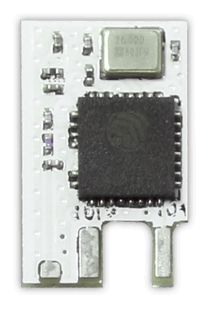
-
Negative view:
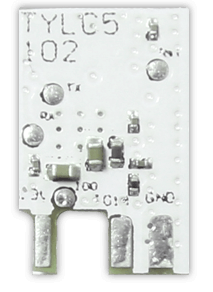
Module interface
Scale package
TYLC5 has 2 rows of pins with the pin pitch being 2mm.
The size of TYLC5: 8.5mm (W)×13.5mm (L) ×3mm (H). The dimensions of TYLC5 is shown in Figure2.
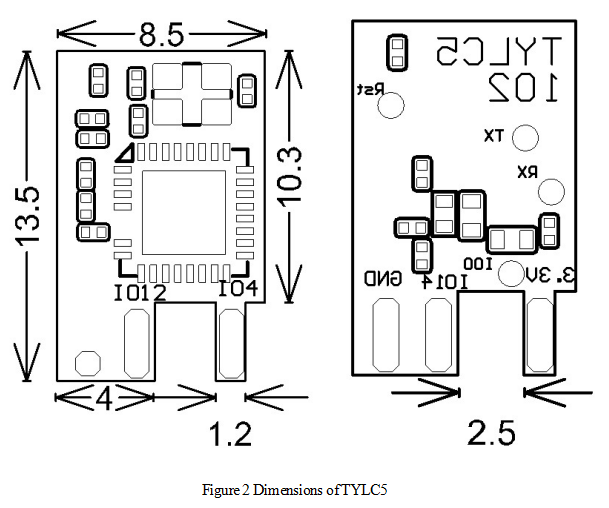
Pin definition
The definition of the interface pins is shown in Table 1.
Table 1 Description of TYLC5’s Interface Pin Arrangement
| Pin No. | Symbol | IO Type | Function |
|---|---|---|---|
| 1 | ANT | - | RF antenna port, spot to solder external antennas |
| 2 | GND | P | Power reference point |
| 3 | GPIO12 | I/O | GPIO_12 |
| 4 | GPIO14 | I/O | GPIO_14 |
| 5 | GPIO4 | I/O | GPIO_04 |
| 6 | VCC | P | Power pin of the module (3.3V) |
Note:
Prepresents the power pin, andI/Orepresents the input and output pin.
Definition of the test points
The definition of the test pins is shown in Table 2.
Table 2 Description of TYLC5’s Test Pin Arrangement
| Pin No. | Symbol | IO Type | Function |
|---|---|---|---|
| - | TP1 | Rst | Hardware reset pin; Cannot clear the distribution network information of Wi-Fi. |
| - | TP 2 | I/O | GPIO0;Testing the module production. |
| - | TP3 | U0TXD | User serial port; Information output from the serial port can be used for testing the module production. |
| - | TP4 | U0RXD | User serial port; Information output from the serial port can be used for testing the module production. |
Electrical parameters
Absolute electrical parameters
Table 3 Absolute Parameters
| Parameter | Description | Min | Max | Unit |
|---|---|---|---|---|
| Ts | Storage temperature | -40 | 125 | ℃ |
| VCC | Supply voltage | -0.3 | 3.6 | V |
| Electrostatic discharge voltage (Human body model) | TAMB-25℃ | - | 2 | KV |
| Electrostatic discharge voltage (Machine model) | TAMB-25℃ | - | 0.5 | KV |
Operating conditions
Table 4 Conditions for Normal Operating
| Parameter | Description | Min | Typical | Max | Unit |
|---|---|---|---|---|---|
| Ta | Operating temperature | -40 | - | 105 | ℃ |
| VCC | Operating voltage | 3.0 | 3.3 | 3.6 | V |
| VIL | IO low-level input | -0.3 | - | VCC*0.25 | V |
| VIH | IO high-level input | VCC*0.75 | - | VCC | V |
| VOL | IO low-level input | - | - | VCC*0.1 | V |
| VoH | IO high-level input | VCC*0.8 | - | VCC | V |
| Imax | IO drive current | - | - | 12 | mA |
Power consumption of Wi-Fi transmission
Table 5 Power Consumption of Continuous TX Transmission
| Symbol | Parameter | Typical | Unit | ||
|---|---|---|---|---|---|
| Mode | Rate | Transmit power | |||
| IRF | 11b | 11Mbps | +17dBm | 220 | mA |
| IRF | 11g | 54Mbps | +15dBm | 110 | mA |
| IRF | 11n | MCS7 | +13dBm | 100 | mA |
Power consumption of Wi-Fi reception
Table 6 Power Consumption of Continuous RX Reception
| Symbol | Mode | Rate | Typical | Unit |
|---|---|---|---|---|
| IRF | 11b | 11Mbps | 76 | mA |
| IRF | 11g | 54Mbps | 76 | mA |
| IRF | 11n | MCS7 | 76 | mA |
Power consumption in the working mode
Table 7 Working Current of TYLC5
| Working Mode | Working State,Ta=25℃ | Average | Max | Unit |
|---|---|---|---|---|
| Easy mode | Wi-Fi indicator flashes quickly. | 80 | 415 | mA |
| Hotspot mode | Wi-Fi indicator flashes slowly. | 90 | 451 | mA |
| Network connection | Wi-Fi indicator is always on. | 58.5 | 411 | mA |
| Network disconnection | Wi-Fi indicator is always off. | 80 | 430 | mA |
Characteristics of radio frequency
Basic characteristics of radio frequency
Table 8 Basic Characteristics of Radio Frequency
| Parameter | Description |
|---|---|
| Working frequency | 2.412~2.484GHz |
| Wi-Fi standard | IEEE 802.11b/g/n(Channel 1-14) |
| Rate of data transmission | 11b: 1, 2, 5.5, 11 (Mbps) 11g: 6, 9, 12, 18, 24, 36, 48, 54(Mbps) 11n: HT20 MCS0-7 |
| Type of antenna | External antenna soldered |
Output power of Wi-Fi
Table 9 Power of Continuous TX Transmission
| Parameter | Min | Typical | Max | Unit | |
|---|---|---|---|---|---|
| Average output power of RF, 802.11b CCK Mode | 1M | - | 20 | - | dBm |
| Average output power of RF, 802.11g OFDM Mode | 54M | - | 17 | - | dBm |
| Average output power of RF, 802.11n OFDM Mode | MCS7 | - | 14 | - | dBm |
| Frequency error | - | -10 | - | 10 | ppm |
Sensitivity of receiving Wi-Fi
Table 10 RX Sensitivity
| Parameter | Min | Typical | Max | Unit | |
|---|---|---|---|---|---|
| PER<8%, RX Sensitivity, 802.11b CCK Mode | 1M | - | -91 | - | dBm |
| PER<10%, RX Sensitivity, 802.11g OFDM Mode | 54M | - | -75 | - | dBm |
| PER<10%, RX Sensitivity, 802.11n OFDM Mode | MCS7 | - | -72 | - | dBm |
Antennas
Type of antennas
They are external antennas soldered to the ANT pad of the module.
Reducing antenna interference
When an external antenna is soldered to the Wi-Fi module, to optimize the Wi-Fi performance, it is recommended that the distance between the antenna part and the other metal parts be at least 10 mm.
Packaging information and production guide
Mechanical dimensions
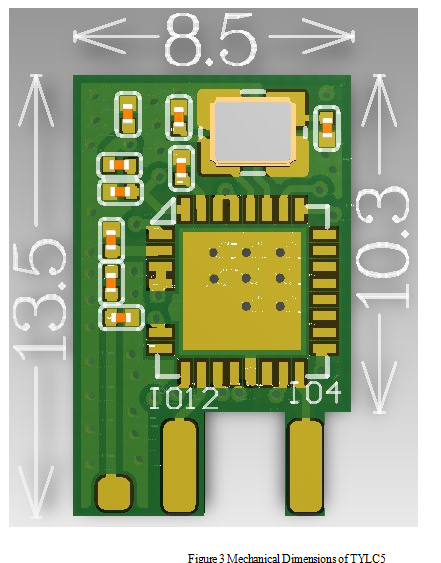
Recommended Package for PCB
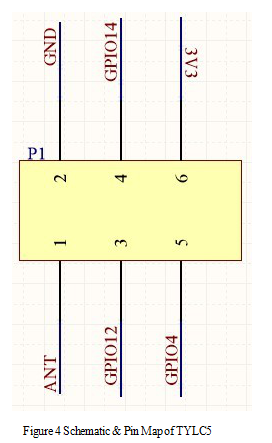
Production instructions
-
For the in-line module developed by Tuya, wave soldering equipment is most preferred and manual soldering is less preferred. After being unpacked, the module must be soldered within 24 hours. Otherwise, it must be put into the drying cupboard where the RH is not greater than 10%, or it needs to be packaged under vacuum again and record the exposure time (the total exposure time cannot exceed 168 hours).
-
Soldering equipment and materials:
- Wave soldering equipment
- Wave soldering fixture
- Constant-temperature soldering iron
- Tin bar, tin wire, and flux
- Oven temperature tester
-
Baking equipment:
- Cabinet oven
- Anti-static heat-resistant pallets
- Anti-static heat-resistant gloves
-
The module needs to be baked in the following cases:
- The vacuum packing bag was found to be damaged before being unpacked.
- There is no humidity indicator card (HIC) in the vacuum packing bag.
- After being unpacked, 10% and above circles on the HIC become pink.
- The total exposure time has been more than 168 hours since unpacking.
- More than 12 months have passed since the sealing date of the bag.
-
Baking settings:
-
Temperature: 40°C and ≤ 5%RH for reelizing and 125°C and ≤5%RH for palletizing (please use a heat-resistant pallet rather than a plastic pallet)
-
Time: 168 hours for reelizing and 12 hours for palletizing
-
Alarm temperature: 50°C for reelizing and 135°C for palletizing
-
Production ready temperature after natural cooling: < 36°C
-
The number of drying times: 1
-
Re-baking requirement: If a module remains unused for 168 hours after being unpacked, it must be baked again.
Important: If this batch of modules is not baked within 168 hours, do not use the wave soldering to solder them. Because the modules are 3-level moisture-sensitive components, they are very likely to get damp when exposed outside. In this case, if they are soldered at high temperatures, it may result in component failure or poor soldering.
-
-
In the whole production process, take electrostatic discharge (ESD) protective measures.
-
To guarantee the quality of products, you must pay attention to the following items:
- The amount of soldering flux.
- The height of the wave peak.
- Whether the tin slag and copper content in the wave soldering tank exceed standards.
- Whether the window and thickness of the wave soldering fixture are appropriate.
- Whether the wave soldering oven temperature curve is reasonable.
Recommended oven temperature curve and temperature
For oven temperature settings, refer to oven temperatures for wave soldering. The peak temperature is 260°C±5°C. The wave soldering temperature curve is shown below:
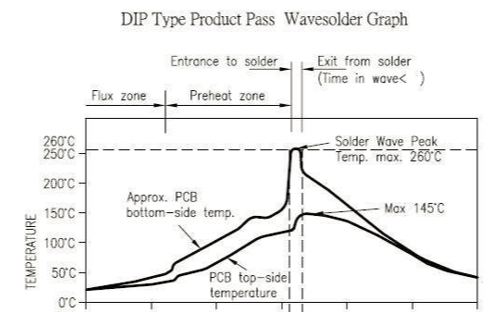
Recommended soldering temperature:
| Recommended wave soldering oven temperature | Recommended manual soldering temperature | ||
|---|---|---|---|
| Preheat temperature | 80 to 130 °C | Soldering temperature | 360±20°C |
| Preheat time | 75 to 100s | Soldering time | <3s/point |
| Peak contact time | 3 to 5s | NA | NA |
| Temperature of tin cylinder | 260±5°C | NA | NA |
| Ramp-up slope | ≤2°C/s | NA | NA |
| Ramp-down slope | ≤6°C/s | NA | NA |
Storage conditions
Storage conditions for a delivered module are as follows:
-
The moisture-proof bag is placed in an environment where the temperature is below 40°C and the relative humidity is lower than 90%.
-
The shelf life of a dry-packaged product is 12 months from the date when the product is packaged and sealed.
-
The package contains a humidity indicator card (HIC).
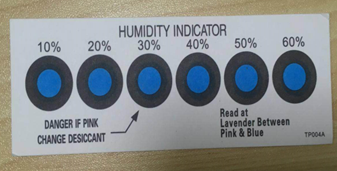
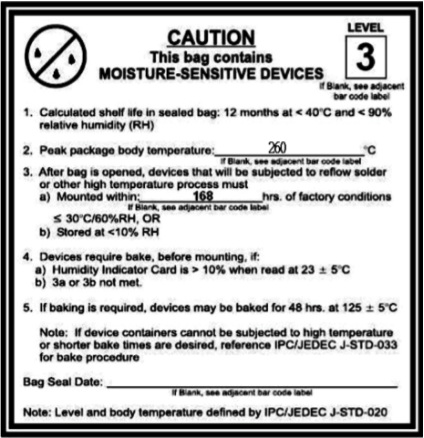
MOQ and packing information
| Product Model | MOQ (pcs) | Packing Method | Number of Modules in Each Reel Pack | Number of Reel Packs in Each Box |
|---|---|---|---|---|
| TYLC5 | 7200 | Carrier tape and reel packing | 1800 | 4 |
Appendix: Statement
FCC Caution: Any changes or modifications not expressly approved by the party responsible for compliance could void the user’s authority to operate this device.
This device complies with Part 15 of the FCC Rules. Operation is subject to the following two conditions: (1) This device may not cause harmful interference, and (2) this device must accept any interference received, including interference that may cause undesired operation.
Note: This device has been tested and found to comply with the limits for a Class B digital device, according to part 15 of the FCC Rules. These limits are designed to provide reasonable protection against harmful interference in a residential installation. This device generates, uses, and can radiate radio frequency energy and, if not installed and used following the instructions, may cause harmful interference to radio communications. However, there is no guarantee that interference will not occur in a particular installation.
If this device does cause harmful interference to radio or television reception, which can be determined by turning the device off and on, the user is encouraged to try to correct the interference by one or more of the following measures:
- Reorient or relocate the receiving antenna.
- Increase the separation between the device and receiver.
- Connect the device to an outlet on a circuit different from that to which the receiver is connected.
- Consult the dealer or an experienced radio/TV technician for help.
Radiation Exposure Statement
This device complies with FCC radiation exposure limits set forth for an uncontrolled rolled environment. This device should be installed and operated with a minimum distance of 20cm between the radiator and your body.
Important Note
This radio module must not be installed to co-locate and operate simultaneously with other radios in the host system except by following FCC multi-transmitter product procedures. Additional testing and device authorization may be required to operate simultaneously with other radios.
The availability of some specific channels and/or operational frequency bands are country dependent and are firmware programmed at the factory to match the intended destination. The firmware setting is not accessible to the end-user.
The host product manufacturer is responsible for compliance with any other FCC rules that apply to the host not covered by the modular transmitter grant of certification. The final host product still requires Part 15 Subpart B compliance testing with the modular transmitter installed.
The end-user manual shall include all required regulatory information/warnings as shown in this manual, including “This product must be installed and operated with a minimum distance of 20 cm between the radiator and user body”.
This device has got an FCC ID: 2ANDL-TYLC5. The end product must be labeled in a visible area with the following: “Contains Transmitter Module FCC ID: 2ANDL-TYLC5”.
This device is intended only for OEM integrators under the following conditions:
The antenna must be installed such that 20cm is maintained between the antenna and users, and the transmitter module may not be co-located with any other transmitter or antenna.
As long as the 2 conditions above are met, further transmitter tests will not be required. However, the OEM integrator is still responsible for testing their end-product for any additional compliance requirements required with this module installed.
Declaration of Conformity European Notice

Hereby, Hangzhou Tuya Information Technology Co., Ltd declares that this module product is in compliance with essential requirements and other relevant provisions of Directive 2014/53/EU,2011/65/EU. A copy of the Declaration of Conformity can be found at https://www.tuya.com.

This product must not be disposed of as normal household waste, in accordance with the EU directive for waste electrical and electronic equipment (WEEE-2012/19/EU). Instead, it should be disposed of by returning it to the point of sale, or to a municipal recycling collection point.
The device could be used with a separation distance of 20cm from the human body.
Is this page helpful?
YesFeedbackIs this page helpful?
YesFeedback





